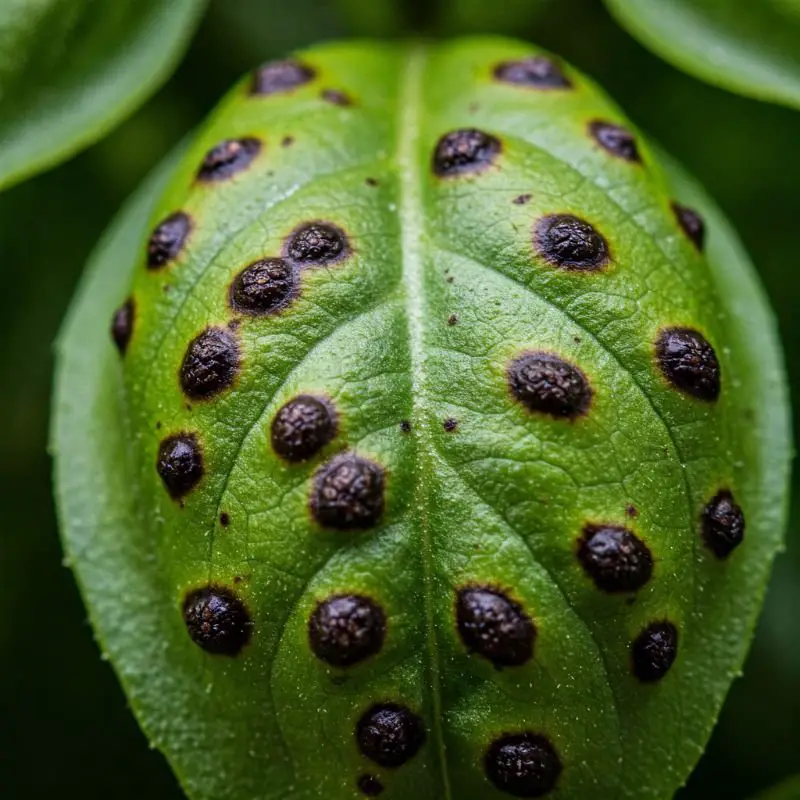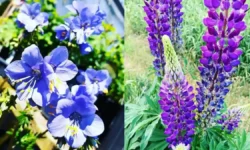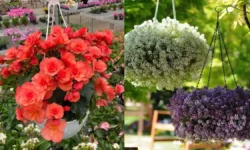Basil is one of the most popular herbs in home gardens, prized for its fresh aroma and culinary versatility. Its lush green leaves are a symbol of healthy, thriving plants, but sometimes gardeners notice black spots in basil leaves that can be alarming. These spots can signal different issues, ranging from fungal infections to pest infestations, improper watering, or environmental stress. Understanding why these black spots appear is crucial to saving your basil plants and keeping them vibrant.
In this detailed guide, we will explore the common causes behind black spots, how to identify the underlying problem, and effective treatments to restore your basil’s health. Whether you grow basil indoors or outdoors, these insights will help you maintain strong and healthy plants.
Table of Contents
Understanding Why Black Spots in Basil Leaves Appear

Fungal and Bacterial Infections
One of the most frequent reasons for black spots in basil leaves is fungal or bacterial infection. Fungal diseases such as downy mildew, fusarium wilt, or cercospora leaf spot often thrive in warm, humid conditions. These pathogens attack the leaf tissue, causing dark spots that may expand over time. Similarly, bacterial infections can create water-soaked lesions that turn black as the infection progresses. When left untreated, these diseases can spread quickly, damaging most of the plant and reducing its ability to photosynthesize.
The presence of spores or mold-like growth on the underside of the leaves can confirm a fungal issue. Bacterial infections, on the other hand, may produce a slimy texture or yellow halos around the blackened areas. Poor air circulation, high humidity, and overhead watering are common factors that encourage these diseases to spread.
Pest Damage Leading to Black Spots
Insects can also be responsible for black spots in basil leaves. Pests such as aphids, thrips, or spider mites feed on the sap of basil leaves, leaving behind tiny wounds that may later turn black as the tissue becomes damaged or infected. Some pests also secrete honeydew, a sticky substance that attracts sooty mold. This mold can create a black coating over the leaves, which sometimes gets mistaken for disease-related black spots.
Checking the underside of leaves is crucial to determine if pests are the culprit. Small insects, fine webbing, or eggs are clear signs of an infestation. Pest damage is often localized, with black spots appearing mostly where the insects have been feeding.
Environmental Stress and Poor Growing Conditions
Environmental stress is another common reason for black spots in basil leaves. Basil thrives in warm temperatures, well-drained soil, and plenty of sunlight. When subjected to stress, such as overwatering, underwatering, or sudden temperature fluctuations, the leaves may develop blackened areas as a response. Excessive water, for instance, can cause root rot, which eventually affects leaf health. Meanwhile, exposure to cold drafts or frost can lead to tissue damage, turning parts of the leaf black.
Nutrient deficiencies, particularly calcium or magnesium, can also manifest as dark spots or necrotic patches on leaves. Soil that is too compact or lacks proper drainage further exacerbates the problem, creating conditions that stress the plant.
Physical Damage or Mechanical Injury
Sometimes the explanation is simpler than disease or pests. Physical damage caused by rough handling, pruning injuries, or contact with hard objects can bruise basil leaves, leaving dark or blackened spots. These injuries might not threaten the overall health of the plant, but they can make the leaves look unsightly. Mechanical damage can also make the plant more susceptible to infections if the wounds are exposed to moisture and pathogens.
How to Identify the Cause of Black Spots in Basil Leaves
Observing the Pattern and Location of the Spots
Identifying the cause starts with closely observing where and how the spots appear. Fungal or bacterial infections often create irregularly shaped black or brown lesions that may spread across multiple leaves. Pest-related spots tend to be smaller and concentrated around feeding areas, often accompanied by visible insects or webbing. Environmental stress usually causes more uniform blackening, often along leaf edges or tips.
Examining the stem and soil conditions can also provide clues. Root rot from overwatering, for instance, may cause wilting along with black spots. A healthy root system with firm, white roots usually indicates that the problem lies in the leaves rather than the soil.
Checking for Additional Symptoms
Other symptoms can help narrow down the cause. Yellowing leaves combined with black spots often point to nutrient deficiencies or bacterial infections. A powdery or fuzzy coating suggests fungal growth. Sticky leaves are a sign of pest activity, especially if accompanied by sooty mold. Wilting, stunted growth, or leaf drop may indicate more severe systemic issues.
Considering Recent Growing Conditions
Think about any recent changes in your basil’s environment. Has the weather been unusually humid or cold? Did you recently overwater or change the plant’s location? Environmental stress often coincides with sudden shifts in temperature, excessive rainfall, or inconsistent watering habits. Tracking these factors can help determine whether cultural practices need adjustment.
How to Treat Black Spots in Basil Leaves
Improving Air Circulation and Growing Conditions
For fungal and bacterial issues, one of the most effective treatments is improving air circulation around the plants. Space basil plants adequately and prune overcrowded areas to allow better airflow. Avoid watering from above, as wet leaves create an ideal environment for fungal spores. Instead, water at the soil level early in the morning so that any splashes on leaves can dry quickly.
Ensuring proper drainage is equally important. Basil should be planted in loose, well-drained soil to prevent waterlogging, which can lead to root diseases that manifest as leaf spots. If growing in containers, check that the pots have sufficient drainage holes.
Using Natural or Organic Treatments
Organic fungicides made from neem oil or copper-based solutions can help control fungal infections if applied early. Neem oil is also effective against many pests, making it a versatile treatment option. Always test a small area before applying any treatment widely to ensure the plant does not react negatively. For bacterial infections, removing infected leaves is often necessary to prevent further spread.
Pest control should begin with simple methods such as washing leaves with water to dislodge insects or introducing beneficial insects like ladybugs. In severe cases, insecticidal soap or neem oil can be used as a safe, organic option.
Pruning and Removing Affected Leaves
Regular pruning is essential for keeping basil healthy. If black spots are limited to a few leaves, carefully prune and dispose of them to prevent the spread of disease. Use clean, sterilized scissors or pruning shears to avoid transferring pathogens. Always discard infected leaves away from the garden rather than composting them, as some fungal spores can survive and re-infect plants.
Adjusting Watering and Fertilization Practices
Correcting watering habits can significantly reduce black spot problems. Basil prefers evenly moist but not soggy soil. Overwatering not only stresses the roots but also encourages fungal and bacterial growth. Allow the soil to dry slightly between watering sessions. Fertilize the plant with a balanced, organic fertilizer to address nutrient deficiencies that may contribute to leaf discoloration.
Protecting Basil from Environmental Stress
If temperature fluctuations are an issue, consider moving potted basil indoors during cold nights or providing row covers in the garden. Keep basil in a sunny location with at least six hours of direct sunlight daily. Maintaining consistent care helps strengthen the plant’s natural defenses, making it less susceptible to black spots.
Preventing Black Spots in Basil Leaves
Maintaining Proper Garden Hygiene
Prevention is always better than treatment. Keep the area around basil plants clean and free of decaying plant matter, which can harbor pests and disease-causing organisms. Rotate basil planting locations each season to minimize the buildup of soil-borne pathogens.
Choosing Disease-Resistant Varieties
Some basil varieties are more resistant to diseases such as downy mildew. If you frequently struggle with black spots, consider planting these resistant cultivars. Healthy seedlings from reputable sources are less likely to carry hidden infections.
Regular Monitoring and Early Intervention
Regularly inspecting your basil plants ensures that any issues are caught early. At the first sign of black spots, take action to identify and treat the problem before it spreads. Consistent monitoring, combined with good gardening practices, keeps basil vibrant and productive.
FAQs About Black Spots in Basil Leaves
What is the most common cause of black spots in basil leaves?
Fungal infections are the most common cause, especially in humid conditions, but pests and environmental stress can also contribute.
Can I still eat basil leaves with black spots?
If the spots are caused by physical damage and not disease, the leaves are generally safe to eat. However, discard leaves affected by fungal or bacterial infections.
How do I prevent black spots in basil leaves?
Provide good air circulation, avoid overhead watering, and keep the soil well-drained. Regular monitoring and proper pruning also help.
Will black spots kill my basil plant?
Mild spotting won’t kill the plant, but severe infections or root problems can weaken it significantly if left untreated.
Should I remove all leaves with black spots?
Yes, remove and dispose of affected leaves to prevent disease spread and encourage healthy new growth.
Conclusion
Black spots in basil leaves can be caused by several factors, including fungal or bacterial infections, pest damage, environmental stress, or simple physical injury. Identifying the underlying cause is essential for effective treatment. By improving air circulation, adjusting watering habits, using natural treatments, and maintaining proper garden hygiene, you can restore your basil to full health.
Healthy basil plants thrive best in well-drained soil, plenty of sunlight, and consistent care. Early detection and preventive measures are key to avoiding severe damage. With the right approach, you can enjoy fresh, green basil leaves all season long without worrying about unsightly black spots.






